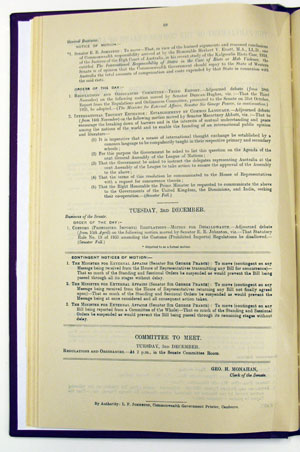60 Reports of committees—precedence
A motion for the consideration or adoption of the report of a committee of the Senate and any government statement on such a report shall take precedence of any other general business on the day on which it is set down for consideration.
Amendment history
Adopted: 1 August 1934, J.459–61 (to take effect 1 October 1934), as SO 66B
Amended: 23 August 1979, J.883–84 (to include reference to government statements – that is, government responses to committee reports)
1989 revision: Old SO 66B renumbered as SO 60 and expression simplified
Commentary

The Senate Notice Paper of 29 November 1935 showing the first listing of a committee report for consideration as a general business order of the day
Standing order 60 was adopted in 1934 in the context of the establishment, two years earlier, of the Regulations and Ordinances Committee (see SO 23) and largely as a result of a suggestion by that committee. Its first report was presented on 18 May 1932 but not considered until 28 September 1932.[1] The chairman, Senator Sir Hal Colebatch (Nat, WA), complained about the lowly treatment of the committee’s report as private business and informed the Senate that, at the suggestion of other members of the committee, he had written to the Standing Orders Committee to seek a solution:
I have no wish that a report of a committee of the Senate shall be given special precedence; but it should not be treated as private business. It should be at the discretion of the Leader of the Senate, in arranging the business paper, to place the consideration of such a report immediately following any urgent Government business which the Government desires to dispose of. Had that been done in the case of this report, the Senate would have had an opportunity to consider it some months ago.[2]
The solution was old SO 66B which was also intended to provide opportunities for the work of the joint committees, the Public Works Committee and the Public Accounts Committee, to be considered.[3] At the same time, the precursor to SO 58 (business of the Senate) was amended to amplify the scope of disallowance motions that were to be given precedence. By these means, the work of the Regulations and Ordinances Committee would receive appropriate priority in the Senate. A concomitant change in terminology from “private” to “general” business reflected the widening of the Senate’s horizons as it took on a broader diversity of work, particularly committee work.
The new standing order can be seen in operation for the first time in the Notice Paper for Friday, 29 November 1935 where two general business orders of the day are listed, the first, for the consideration of the Third Report of the Regulations and Ordinances Committee, being listed ahead of an order of the day for resumption of debate on a motion for an International Thought Exchange.
By the time the standing order was amended in 1979, committee work had become major business and the Senate had expressed an opinion by resolution in 1973 that governments should respond to recommendations in committee reports within a period of three months of the report being presented.[4] The resolution had little effect, however, and the Standing Orders Committee recommended the Senate agree to a stronger resolution requesting a response within three months and requiring the President to report to the Senate those cases where there had been no response within the timeframe.[5] The government made a statement in May 1978 that it would try to adhere to a six month timeframe, and the committee’s recommendation for a stronger resolution was recommitted for further consideration.[6] The committee accepted the government’s position but recommended that the President present a report from time to time on government responses outstanding, and also recommended changes to the standing order that would add these government responses to the category of general business to be given precedence over other general business on the day it was set down for consideration. Both recommendations were adopted, the committee noting that the Senate Records Office (now the Table Office) had established a register to record the dates of committee reports and government responses to them.[7] This register continues to be the basis of the President’s biannual report to the Senate on government responses outstanding, generally in June and December.
For the time being the Notice Paper listed orders of the day for consideration of committee reports and government responses ahead of other general business orders of the day under a common heading but, from 7 September 1982, committee reports and government responses had a separate section to themselves in the Notice Paper, between general business notices of motion and general business orders of the day.[8]
Standing order 60 has little current application because SO 62 offers a better solution. The routine of business provides up to an hour for the consideration of committee reports, government responses and Auditor-General’s reports after general business on Thursdays under SO 62.